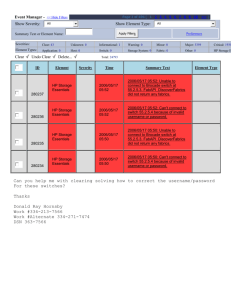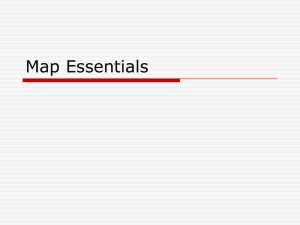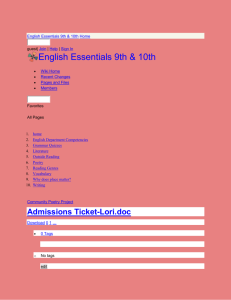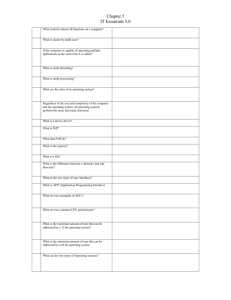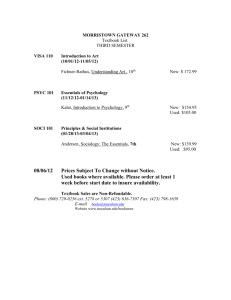Chapter 12
advertisement
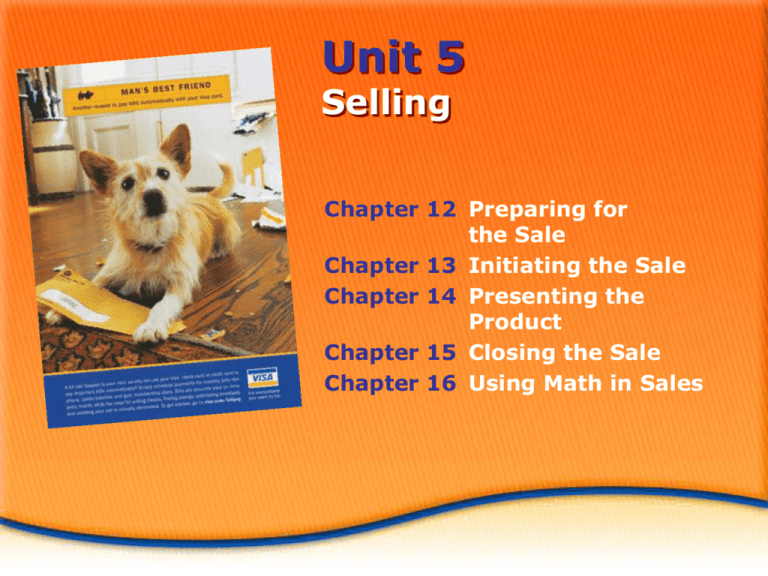
Unit 5 Selling Chapter 12 Preparing for the Sale Chapter 13 Initiating the Sale Chapter 14 Presenting the Product Chapter 15 Closing the Sale Chapter 16 Using Math in Sales Chapter 12 Preparing for the Sale • Section 12.1 What Is Selling? • Section 12.2 Getting Ready To Sell What Is Selling? Key Terms personal selling business-tobusiness selling telemarketing consultative selling feature-benefit selling product features customer benefits rational motive emotional motive extensive decision making limited decision making routine decision making Objectives Define selling and different types of selling situations Explain the purpose and goals of selling Define consultative selling Marketing Essentials Chapter 12, Section 12.1 What Is Selling? Objectives Differentiate between rational and emotional buying motives List three levels of customer decision making Marketing Essentials Chapter 12, Section 12.1 Marketing and the Marketing Concept Graphic Organizer Create a chart to record important information about selling situations and customers’ decision making. Marketing Essentials Chapter 12, Section 12.1 Selling personal selling Any form of direct contact between a salesperson and a customer. Personal selling X is any form of direct contact between a salesperson and a customer. Retail selling is unique because customers come to the store. The salesperson should be available to answer any questions about the product. Marketing Essentials Chapter 12, Section 12.1 Selling business-tobusiness selling Sales that take place in a manufacturer’s or wholesaler’s showroom (inside sales) or in a customer’s place of business (outside sales). Business-to-business selling X may take place in a manufacturer’s or wholesaler’s showroom (inside sales) or a customer’s place of business (outside sales). In the latter case, the salesperson needs to make contact with the customer. Marketing Essentials Chapter 12, Section 12.1 Selling telemarketing The process of selling over the telephone. Telemarketing X is the process of selling over the telephone. Telemarketers are regulated by the Do Not Call Registry established by the Federal Communications Commission. Marketing Essentials Chapter 12, Section 12.1 Goals of Selling The purpose and goals of selling are to: • Help customers make satisfying buying decisions • Create ongoing, profitable relationships between buyer and seller Marketing Essentials Chapter 12, Section 12.1 Goals of Selling If a business is successful at keeping customers happy, the customers are likely to pass along positive recommendations to: • Other business associates • Friends • Family Marketing Essentials Chapter 12, Section 12.1 Consultative Selling consultative selling Sales that provide solutions to customers’ problems by finding products that meet their needs. Consultative selling X is the process of providing solutions to customers’ problems by finding products that meet their needs. To be effective in consultative selling, you need to understand feature-benefit selling. Marketing Essentials Chapter 12, Section 12.1 Feature-Benefit Selling featurebenefit selling Sales that match the characteristics of a product to a customer’s needs and wants. product features Matching the characteristics of a product to a customer’s needs and wants is a concept called feature-benefit selling X. Product features X may be any of three types of product attributes: basic, physical, or extended. Basic, physical, or extended attributes of a product or purchase. Marketing Essentials Chapter 12, Section 12.1 Feature-Benefit Selling customer benefits The advantages or personal satisfaction a customer will get from a good or service. Customer benefits X are the advantages or personal satisfaction a customer will get from a good or service. These include: • The feature helps the product’s performance. • Performance information gives the customer a personal reason to buy the product. Marketing Essentials Chapter 12, Section 12.1 Feature-Benefit Selling After identifying the features of a product and their benefits, you should put together a featurebenefit chart to match each feature with a customer benefit. Marketing Essentials Chapter 12, Section 12.1 Customer Buying Motives rational motive A conscious, logical reason for a purchase. Customers have rational or emotional motives for making purchases. A rational motive X is a conscious, logical reason for a purchase, such as dependability, savings, health and safety issues, and quality. Marketing Essentials Chapter 12, Section 12.1 Customer Buying Motives emotional motive A feeling experienced by a customer through association with a product. Emotional motives X are the feelings a customer experiences in association with a product. These include: • Social approval • Recognition • Prestige Marketing Essentials Chapter 12, Section 12.1 Customer Decision Making Some customers do not need help from salespeople while others do. This difference has its roots in three types of decision making: • Extensive • Limited • Routine Marketing Essentials Chapter 12, Section 12.1 Customer Decision Making How a person makes a decision is affected by the following factors: • Previous experience with the product and company • How often the product is purchased • Amount of information necessary to make a wise buying decision Marketing Essentials Chapter 12, Section 12.1 Customer Decision Making • The importance of the purchase to the customer • Perceived risk involved with the purchase • Time available to make the decision Marketing Essentials Chapter 12, Section 12.1 Customer Buying Motives extensive decision making The process used when there has been little or no previous experience with an item. Extensive decision making X is used when there has been little or no previous experience with an item such as goods and services that: • Have a high degree of perceived risk • Are very expensive • Have a high value to the customer Marketing Essentials Chapter 12, Section 12.1 Customer Buying Motives limited decision making The process used when a person buys goods and services that he or she has purchased before but not regularly. Limited decision making X is used when a person buys goods and services that he/she has purchased before but not regularly, such as: • A second car • Certain types of clothing • Furniture and household appliances Marketing Essentials Chapter 12, Section 12.1 Customer Buying Motives A customer makes a purchasing decision based on a variety of factors, including the following: Frequency of the purchase Importance of the purchase Perceived risk of the purchase This ad highlights the features of a minivan. Marketing Essentials Chapter 12, Section 12.1 Customer Buying Motives routine decision making The process used when a person needs little information about a product to make a decision because he or she buys it regularly. Routine decision making X is used when a person needs little information about a product. The perceived risk may be low because the item is inexpensive, bought frequently, or highly satisfying. Marketing Essentials Chapter 12, Section 12.1 SECTION 12.1 REVIEW SECTION 12.1 REVIEW - click twice to continue - Getting Ready to Sell Key Terms pre-approach prospect referrals endless chain method cold canvassing sales quotas Objectives Name sources of product information Explain the main focus of preparation in business-to-business selling and in retail selling Marketing Essentials Chapter 12, Section 12.2 Marketing and the Marketing Concept Graphic Organizer Draw this chart to take notes about sources of product, industry information, and methods of prospecting. Marketing Essentials Chapter 12, Section 12.2 The Pre-Approach pre-approach The preparation for the face-toface encounter with potential customers. The pre-approach X is the preparation for the face-to-face encounter with potential customers. In preparing to assist customers, salespeople must: • Study their products • Know industry trends and competitors Marketing Essentials Chapter 12, Section 12.2 The Pre-Approach • Research potential customers • Develop familiarity with their company’s policies and procedures • Review ethical and legal issues involved in their selling situation. Marketing Essentials Chapter 12, Section 12.2 Product Information Developing product knowledge is easy if you know where to look for the information. Salespeople find product information through four main sources: • Direct experience and written publications • Other people and formal training Marketing Essentials Chapter 12, Section 12.2 Industry Trends Sales representatives read periodicals related to their trade to gain insight into the industry. For example, a clothing sales representative for an apparel manufacturer might read Women’s Wear Daily. Marketing Essentials Chapter 12, Section 12.2 Prospecting prospect A potential customer; also known as a lead. Looking for new customers is called prospecting. A prospect X, or a lead, is a potential customer. Prospecting is especially important in business-tobusiness selling. Marketing Essentials Chapter 12, Section 12.2 Prospecting Some firms employ entire telemarketing teams to generate leads for their sales staffs. They also attend trade shows to display their products. Sales representatives can use trade, professional, and residential directories to contact potential customers not in the Do Not Call Registry. Marketing Essentials Chapter 12, Section 12.2 Prospecting referrals The names of other people who might buy a product, given to salespeople by satisfied customers. endless chain method Satisfied customers often give salespeople referrals X—the names of other people who might buy the product. When salespeople ask previous customers for names of potential customers, they are said to be using the endless chain method X. The process of asking previous customers for names of potential customers. Marketing Essentials Chapter 12, Section 12.2 Prospecting cold canvassing The process of locating as many potential customers as possible without checking out leads beforehand. In cold canvassing X, potential customers are selected at random, such as by going door-to-door or selecting names from a telephone directory. This process is also called blind prospecting. Marketing Essentials Chapter 12, Section 12.2 Preparing for the Sale in Business-to-Business Selling In business-to-business (B-to-B or B2B) sales, pre-approach activities vary. When dealing with a new customer, salespeople should research the following: • Does the prospect need this product or service? • Does the prospect have the financial resources to pay? Marketing Essentials Chapter 12, Section 12.2 Preparing for the Sale in Business-to-Business Selling To answer these questions, you make inquiries by: • Calling other sales representatives who sell noncompeting lines • Reading the company’s annual reports • Subscribing to database listings that monitor businesses’ financial situations Marketing Essentials Chapter 12, Section 12.2 Preparing for the Sale in Retail Selling Preparation centers around the merchandise and work area and includes: • Straightening, rearranging, and restocking • Adjusting price tickets before and after sales • Knowing where and how much stock is available • Arranging displays • Keeping the general area clean Marketing Essentials Chapter 12, Section 12.2 Company Policies and Training Sales management establishes the guidelines and policies under which salespeople function. This process involves scheduling, overseeing, evaluating, and training the staff. Marketing Essentials Chapter 12, Section 12.2 Company Policies and Training This four-step process is often used to train new sales personnel: • Explanation • Demonstration • Trial • Critique Marketing Essentials Chapter 12, Section 12.2 Company Policies and Training sales quotas Dollar or unit sales goals set for the sales staff to achieve in a specified period of time. Salespeople are compensated by straight commission, straight salary, or salary plus commission. Managers often establish sales quotas. Sales quotas X are dollar or unit sales goals set for the sales staff to achieve in a specified period of time. Marketing Essentials Chapter 12, Section 12.2 Company Policies and Training Commission sales and sales quotas can create pressure on the sales staff to produce sales. Salespeople must be sure not to engage in hardsell tactics or lie to a prospective customer. Marketing Essentials Chapter 12, Section 12.2 Company Policies and Training A purchase contains all the elements of a legal contract: • An offer or acceptance • Consideration (price and terms) • Competent parties (buyer and seller) • Legal form and subject matter Marketing Essentials Chapter 12, Section 12.2 Company Policies and Training In a contract to provide services, all services and materials that will be used should be clearly identified. Marketing Essentials Chapter 12, Section 12.2 SECTION 12.2 REVIEW SECTION 12.2 REVIEW - click twice to continue - Section 12.1 • Three types of selling situations are retail, business-to-business, and telemarketing. • Matching the characteristics of a product to a customer’s needs and wants is feature-benefit selling. continued Section 12.2 • To prepare for a sale, salespeople study their products, industry trends, competitors, and customers, as well as company policies and legal and ethical selling issues. • A prospect or lead is a potential customer. This chapter has helped prepare you to meet the following DECA performance indicators: • Acquire product information for use in selling. • Explain key factors in building a clientele. • Describe the use of technology in the selling function. • Demonstrate customer-service mindset. • Make oral presentations. CHAPTER 12 REVIEW CHAPTER 12 REVIEW - click twice to continue -


